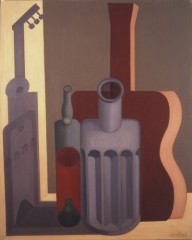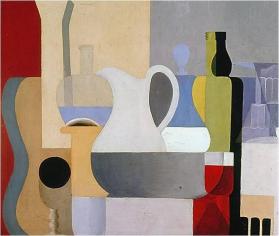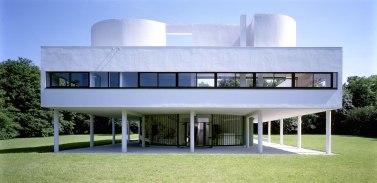Hi guys! This semester I have a course Arch 222 which is about history of architecture and I had a presentation about Purism in this course two weeks ago. Today, I am sharing with you the article written by me about ‘Purism’ movement which came up in the beginning of twentieth century and was led by Ozenfant and Le Corbusier. I hope, you enjoy while reading this article. 🙂
ABSTRACT
With the industrial revolution, there have been some developments and changes in the field of art and architecture. Various styles of new modern art and architecture appeared just as cubism, de stijl and purism. Purism movement in art arised under the leadership of Le Corbusier and Amédée Ozenfant in beginning of twentieth century. These two guys met for the first time in 1917. Then, they started to apply the style of purism in art and to diffuse it other artists. Their main aim about art and architecture was to create a style of art which was made up of pure, simple, natural and primary geometrical elements in a well-organised mathematical order. And, according to them, this new style of modern art should be universal and it could be accepted from everybody in anywhere and anytime.
INTRODUCTION
‘The great works of the past are those based on primary elements, and this is the only reason why they endure.’ (Le Corbusier).[1]
After the industrial revolution, lots of types of art movements came up because with new technological possibilities and various materials, there has been some changes and developments in the field of art and architecture. Around those times, Le Corbusier and Amedee Ozenfant met for the first time in 1917. Le Corbusier was a painter, a city designer, a writer, a designer and an architect. Amedee Ozenfant was also a painter and writer. Before that time, they were both interested in the idea of cubism which was the one of modern art movements and they both had some cubist paintings. Then, they realized that cubism started to be much romantic and complex unnecessarily. However, Corbusier argued that pure beauty and esthetical values could be provide via primary geometrical elements and mathematical order. [2]
In 1918, Le Corbusier and Amedee Ozenfant wrote a book named ‘Apres Le Cubisme’ which means ‘After Cubism’. The aim of writing this book was to express their ideas about purism. The book started with the statement of Voltaire: ‘Recession appears as a result of cutting corners, laziness while doing good, indifference to beauty and bizarre pleasures.’ and the last sentence of the book was that: ‘A work of art should not be arbitrary, out of series, impressionist, reactive and picturesage. On the contrary; it should be universal, static and an expression of stability.’ By the help of these sentences, Corbusier and Ozenfant wanted to attract attention to the universal meanings of artistic things because they believed that universality and stability are much more important and valuable in art than privity and dynamism because according to Corbusier, art should be universal and it should have the same meaning at any time and anywhere in the World. [3]
QUICK INFORMATION ABOUT CUBISM AND CUBIST ARTISTS
3 Musicians from Pablo Picasso, 1921.
The Accordionist from Pablo Picasso, 1911.
Violin and Glass from Juan Gris, 1915.
Jacques Lipchitz, 1976.
‘Cubism is like standing at a certain point on a mountain and looking around. If you go higher, things will look different; if you go lower, again they will look different. It is a point of view.’ (Jacques Lipchitz).[4]
These paintings and the sculpture are from the artists who did several works of art in the style of cubism. They wanted to reflect the objects from different perspectives and to create some new angles in order to express the meanings and emotions from the inner world of them. Making use of new lines and angles helped them to create the third dimension on the two dimensional frame and to provide the observer different perceptions from each distances and each sides while looking. Also, cubists looked for the dynamism in their works. Pablo Picasso believed that cubism had tangible goals. They (The Cubists) evaluated it only as a means of expressing what the observer perceived with the eye and the spirit while utilizing all the possibilities that lie within the natural properties of drawing and colours. Because that had become a source of unexpected joy for them, a font of discoveries.[5]
NEW STYLE IN MODERN ART: PURISM
On the contrary, Le Corbusier and Amédée Ozenfant thought that a work of art must be realistic and pure. Even they claimed that art should have a universal meaning and it should be an explanation of stableness. Pure, simple and primary forms are the most beautiful and the most qualified forms. According to Corbusier, a work of art was a labour of putting into order and a masterpiece of human order and it should activate a sensation of a mathematical order. And artists should search the meaning of activating a sensation of a mathematical order among universal language of art rather than individual ones. Hence, Le Corbusier, Ozenfant and the all other artists who adopted the style of purism took advantage of perception of order and collaboration of this order. Corbusier defended that order was one of the fundamental needs of a man just as much as bread or a place to sleep.[6]
Le Corbusier, 1920.
Still Life with Carafe, Bottle and Guitar, Amédée Ozenfant, 1919.
Still Life with Glass and Red Wine, Amédée Ozenfant, 1920.
Red Violin, Le Corbusier, 1920.
Le Corbusier and Amédée Ozenfant used objects of everyday life while painting. They chose objects that are bottle, guitar, glass and any other like these. Then, they painted these objects in a very ordered and detailed composition. Also, they used a few primary colors. Although some artists and people commented on these works as copies, they argued that art should reflect the truth in a pure way.[7] They mentioned about this issue on article ‘Purism’ written by both of them like that: ‘Purism would never permit a bottle of triangular shape because a triangular bottle, which eventually could be produced by a glass-blower, is only an exceptional object, a fantasy, like the idea behind it.’
PURISM IN ARCHITECTURE
It could be considered as Le Corbusier also reflected the style of purism to his works in architecture. After industrial revolution, there has been a significant increase in population in cities because this situation caused lots of job opportunities to people via developments in industry. Therefore, housing shortage started to become a main problem in cities. Le Corbusier decided to hug this new machine age because he thought that people could produce lots of materials via new industrial machines in a very fast and economic way. Also, he believed that economy was an important factor in terms of producing maximum capacity and strength while using minimum materials and effort. And he called his idea as ‘Machine aesthetic of Purism’. He still continued the idea of order and used regulating lines while designing houses, buildings, streets and cities just like he reflected this order principle to his previous purist works of art.[8] Villa Savoye and Unite d’Habitation are the buildings of Corbusier which could be associated with the style of purism even if they were designed and constructed at certain intervals.
VILLA SAVOYE in Poissy, Yvelines, FRANCE from Le Corbusier, 1931.
Unite d’Habitation in Marseille, France from Le Corbusier, 1952.
Villa Savoye is a building which has a rectangular shape. Here, it can be mentioned that Corbusier still designed his ideas in the light of purism because he used primary forms. There is not any complexity in facades of the house. Additionally, Le Corbusier used lots of structural elements ordered systematically so by the help of this structural system, Corbusier was able to both design inside walls of the building independently and supply more sunlight and fresh air possibility. Even, Le Corbusier had a chance to design every floor in a different composition because inside walls of the building are no more load-bearing walls.
As seen in the pictures, Unite d’Habitation was designed by Le Corbusier as a housing unit included an 18-storey slab block. Le Corbusier described the building as ‘a machine for living in’ because this huge building was housing 337 apartments, shopping streets, a hotel and some socializing spaces in rooftop terrace. Again, just like the style of purism, Le Corbusier chose a certain geometrical shape for the design idea. Mathematical order can be easily observed throughout the building and usage of primary colors is in a very harmonic way in this order.
Consequently, it is worth to explain the relationship between these two buildings from Corbusier and Purism. At the first sight, both were designed as prisms like a box. However, the perfect order and rich designs of the buildings can be realized when they are observed from the inside in a detailed way.[9]
MIES VAN DER ROHE AND PURISM
Mies Van Der Rohe was also interested in purism. His very famous quotation ‘Less is more.’ can be related to purism idea and he also indicated that he did not want to be interesting but he wanted to be good.
Fransworth House in Plato, Illinois from Mies Van Der Rohe, 1951.
DE STIJL
De Stijl movement was also a style of modern art in twentieth century just like cubism and purism. This style was about universality, reality, simplicity and objectivity like purism. De Stijl artists used only horizontal and vertical lines in their paintings. Even, they painted only using three main colors which are red, blue and yellow. So, it is possible to say that De Stijl and Purism were born at the same time and both could be evaluated as anti-cubist movements of art although artists made works of art different from each other. Some well-known De Stijl artists are Piet Mondrian and Gerrit Rietveld.[10]
Piet Mondrian Painting.
Shröder House from Gerrit Rietveld in Utrecht, Holland, 1924.
CONSLUSION
Le Corbusier and Ozenfant wanted to create a style of art which was universal and independent from the time concept. Accoring to them, primary geometrical forms were beautiful and meaningful in themselves. Maybe, the reason why Le Corbusier’s work are still valuable in our age is this attitude and thoughts of him. However, other artists and people at that time started to think that purism was boring, ordinary and stony. Even, they claimed that designing a work of art by using universal style obstructed development of traditional and local art styles. Moreover, Robert Venturi commented on Mies Van Der Rohe’s statement which is ‘Less is more.’ by his own words; ‘Less is bore.’ in 1966.
REFERENCES
Birol, G. Modern Mimarlığın Ortaya Çıkışı ve Gelişimi.
De Heer, J. (2009). The architectonic colour: polychromy in the purist architecture of Le Corbusier. 010 Publishers.
Ganteführer-Trier, A. (2004). Cubism. Taschen.
Guedes, A. (2004). The Paintings and Sculptures of Le Corbusier. Massilia: anuario de estudios lecorbusierianos, (2004), 250-255.
Herbert, R. L. (Ed.). (2000). Modern Artists on Art. Courier Corporation.
Le Corbusier. (1987). The city of to-morrow and its planning. Courier Corporation.
Leenhardt, J. (2002). Modernity Revisited. Critique d’art. Actualité internationale de la littérature critique sur l’art contemporain, (20).
Ozenfant, A., & Jeanneret, C. E. (1999). Après le cubisme. Altamira.
Padovan, R. (2013). Towards Universality: Le Corbusier, Mies and De Stijl. Routledge.
Statton, D. (2012). THE ‘ANTI-PHOTOGRAPHIC’PHOTOGRAPHY OF PABLO PICASSO AND ITS INFLUENCE ON THE DEVELOPMENT OF THE MOVEMENT NOW KNOWN AS CUBISM (Doctoral dissertation, Faculty of Louisiana State University and Agricultural and Mechanical College in partial fulfillment of the requirements for the degree of Master of Arts in The School of Art by Dana Statton BA, Washington and Lee University).
[1] Herbert, R. L. (Ed.). (2000). Modern Artists on Art. Courier Corporation.
[2] Leenhardt, J. (2002). Modernity Revisited. Critique d’art. Actualité internationale de la littérature critique sur l’art contemporain, (20).
[3] Ozenfant, A., & Jeanneret, C. E. (1999). Après le cubisme. Altamira.
[4] Statton, D. (2012). THE ‘ANTI-PHOTOGRAPHIC’PHOTOGRAPHY OF PABLO PICASSO AND ITS INFLUENCE ON THE DEVELOPMENT OF THE MOVEMENT NOW KNOWN AS CUBISM (Doctoral dissertation, Faculty of Louisiana State University and Agricultural and Mechanical College in partial fulfillment of the requirements for the degree of Master of Arts in The School of Art by Dana Statton BA, Washington and Lee University).
[5] Ganteführer-Trier, A. (2004). Cubism. Taschen.
[6] De Heer, J. (2009). The architectonic colour: polychromy in the purist architecture of Le Corbusier. 010 Publishers.
[7] Guedes, A. (2004). The Paintings and Sculptures of Le Corbusier. Massilia: anuario de estudios lecorbusierianos, (2004), 250-255.
[8] Le Corbusier. (1987). The city of to-morrow and its planning. Courier Corporation.
[9] Birol, G. Modern Mimarlığın Ortaya Çıkışı ve Gelişimi.
[10] Padovan, R. (2013). Towards Universality: Le Corbusier, Mies and De Stijl. Routledge.
















